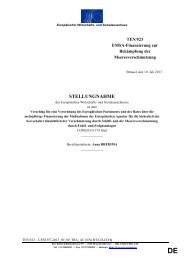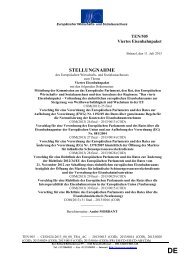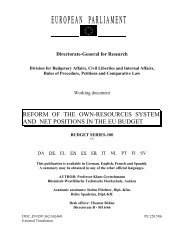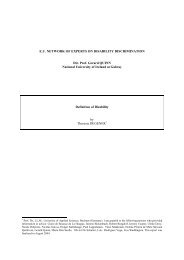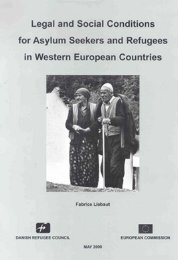Bulgaria - The social impact of seasonal migration
Bulgaria - The social impact of seasonal migration
Bulgaria - The social impact of seasonal migration
Create successful ePaper yourself
Turn your PDF publications into a flip-book with our unique Google optimized e-Paper software.
20<br />
World <strong>Bulgaria</strong> mentions also that the number <strong>of</strong> <strong>Bulgaria</strong>ns in 6 North-european<br />
countries, namely Sweden, Finland, Norway, Denmark, Belgium and the Netherlands, is<br />
around 10 000 people, the majority <strong>of</strong> them in Sweden and Belgium.<br />
It is obvious that there lacks a precise unified methodology for observing e<strong>migration</strong> trends<br />
which leads us to one <strong>of</strong> the most important conclusions <strong>of</strong> the study. <strong>The</strong>re is an urgent need<br />
<strong>of</strong> elaborating such a methodology and establishing <strong>of</strong> a stable, publicly accepted database on<br />
the processes <strong>of</strong> e<strong>migration</strong>, differentiating the period <strong>of</strong> staying abroad. <strong>The</strong>re are no data<br />
about <strong>seasonal</strong> <strong>migration</strong>, let alone the irregular one. Checking the number <strong>of</strong> irregular<br />
emigrants is a very difficult task that requires more efforts and coordination <strong>of</strong> activities<br />
among different institutions, <strong>Bulgaria</strong>n and foreign.<br />
In order to gather some data on the number <strong>of</strong> <strong>Bulgaria</strong>ns engaged in <strong>seasonal</strong> work<br />
abroad, on 8 August 2003 the project team, together with the IOM-S<strong>of</strong>ia branch, sent a<br />
short questionnaire to the mayors <strong>of</strong> all 263 municipalities in <strong>Bulgaria</strong>. Although the data<br />
received are not the result <strong>of</strong> strict and exhaustive checks by municipal clerks, they are<br />
useful because they give an approximate picture <strong>of</strong> the scope <strong>of</strong> <strong>seasonal</strong> <strong>migration</strong> as<br />
perceived by municipal <strong>of</strong>ficials in <strong>Bulgaria</strong>. In our opinion, if the municipalities are<br />
required to gather such data on a regular basis, this could be a valuable source for the<br />
future information database.<br />
<strong>The</strong> questions asked in the questionnaire were how many people exercised <strong>seasonal</strong><br />
work abroad (women or men), for what period <strong>of</strong> time, where, and for what type <strong>of</strong><br />
work. <strong>The</strong> mayors were also asked to briefly evaluate the effect <strong>of</strong> migrant work abroad<br />
on their municipalities. Until 2 September 2003, replies have arrived from 103<br />
municipalities (4 <strong>of</strong> them with more than 50 000 inhabitants), with 8 <strong>of</strong> them saying there<br />
was no available information. According to the approximate estimates <strong>of</strong> the mayors<br />
who have provided data so far, the number <strong>of</strong> migrants doing <strong>seasonal</strong> work is 73 989<br />
people <strong>of</strong> a population <strong>of</strong> 1 173 052 people, or an average <strong>of</strong> 6.3%. <strong>The</strong> top 10<br />
municipalities (from those answered the questionnaire) with the biggest percentage <strong>of</strong><br />
migrants are:<br />
- Momchilgrad (45%), Kurdzhali region<br />
- Rila (25%), Kiustendil region<br />
- Kotel (20%), Sliven region<br />
- Dupnitsa (9-18%), Kiustendil region<br />
- Satovcha (15.3%), Blagoevgrad region<br />
- Tvurditsa (11-14%), Sliven region<br />
- Suedinenie (13.4%), Plovdiv region<br />
- Stamboliiski (13%), Plovdiv region<br />
- Tutrakan (12.1%), Silistra region<br />
- Dzhebel (10.3%), Kurdzhali region<br />
<strong>The</strong> Top 10 municipalities with the biggest absolute number <strong>of</strong> migrants are:<br />
- Momchilgrad (14 000 migrants), Kurdzhali region<br />
- Dupnitsa (5-10 000), Kiustendil region<br />
- Iambol (8 000), Iambol region<br />
- Stamboliiski (3 000), Plovdiv region




